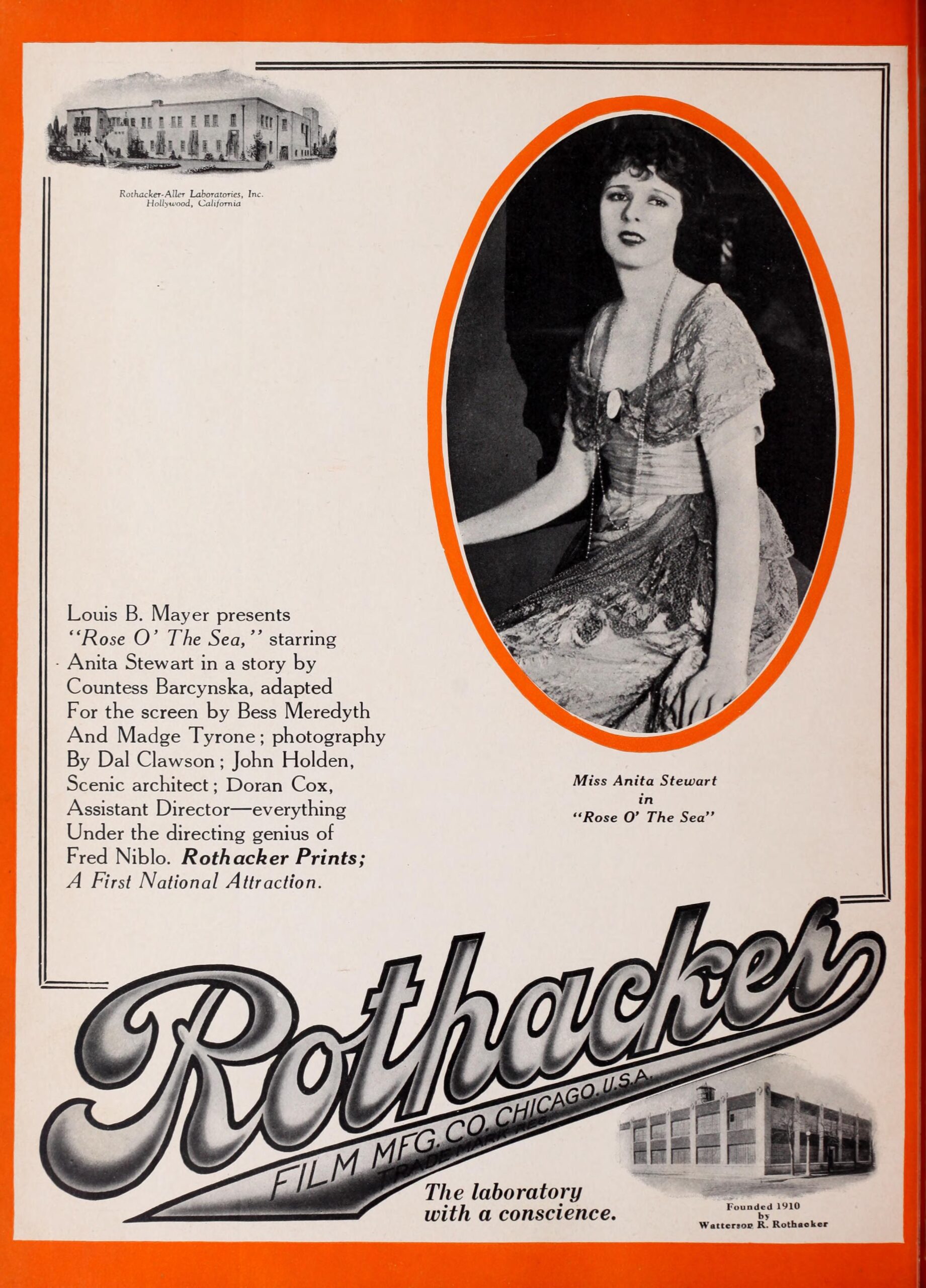
Madge Tyrone is co-credited with Bess Meredyth for adapting Rose o’ the Sea (1922), Motion Picture News, July 26, 1922.
In the early 1920s, Madge Tyrone was classed with Anita Loos, Jeanie MacPherson, and Frances Marion as a scenarist at the top of her game. She worked closely with Louis B. Mayer, who personally wrote a letter of support for her first U.S. passport application. Her death, in 1955, occasioned notice in The New York Times. Despite Tyrone’s reputation and contributions to the industry—as an actress, writer, and editor—her career was, for reasons we will likely never know, relatively short-lived; she has also been completely erased from film history.
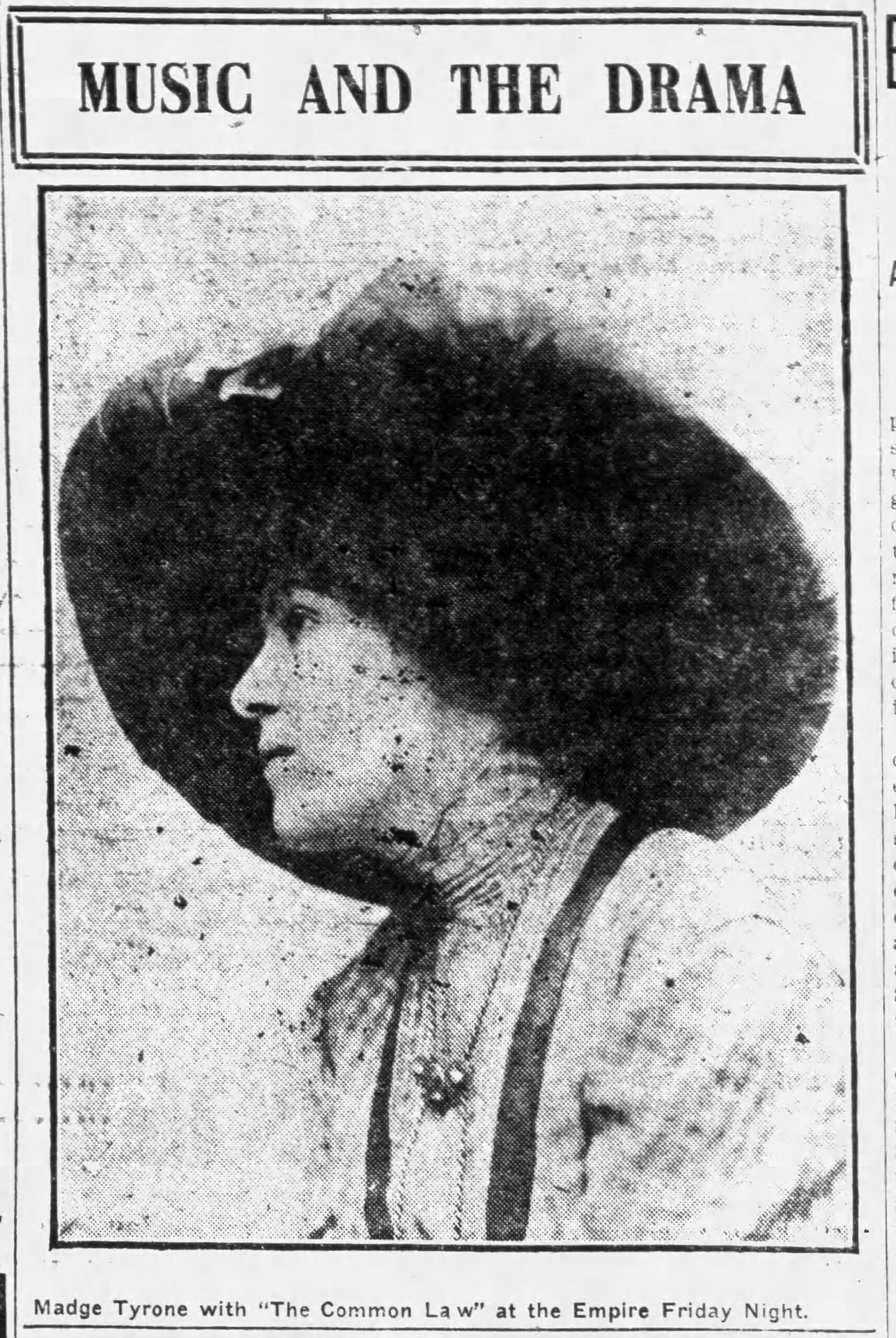
As Madge Tyrone’s theatrical career ascended, her picture often appeared in the press. For example, The Post-Star of Glens Falls, New York, promoted her role in “The Common Law” on September 7, 1912.
Born Margaret Elizabeth Towle in Boston on January 5, 1884, to Irish Catholic parents, Dr. Henry Towle and Elizabeth Mooney, Margaret attended Radcliffe College from 1901 to 1904, though she did not graduate (“Margaret Elizabeth Towle”). Instead, she cast off her birth name to become stage actress Madge Towle before renaming herself Madge Tyrone (Blake; “At the Grand”). In 1909, she performed in San Francisco and Los Angeles in “Pals” with Edwin Carewe, with whom she would reunite when she eventually started making movies. In 1910, Tyrone traveled the country with the singing Irish comedian Fiske O’Hara. Appearing in a bit part as Kitty Adair in the musical “The Wearing of the Green” at Pittsburgh’s Lyceum Theater in February of that year, Tyrone performed alongside “real old-time Irish character players” who sang and danced “with unction and merriment.” This was ethnic, working-class entertainment, exemplifying “the joys and sorrows, the songs and poetry, the sentiment and pathos of Irish character” (“In the Theaters Last Evening”).
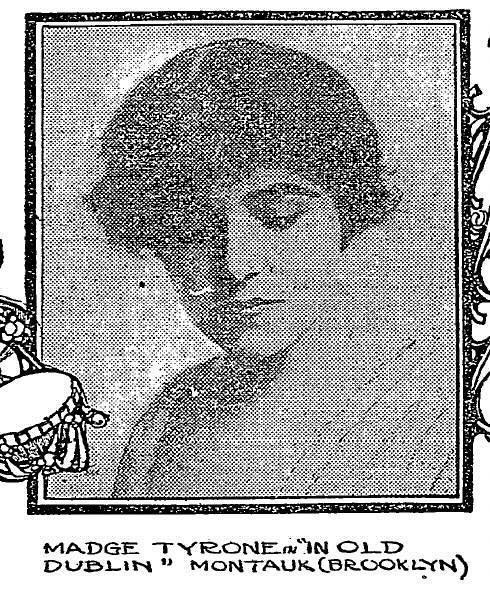
On October 9, 1913, The New York Times published Tyrone’s photograph from “In Old Dublin” while it was being staged at the Montauk Theater in Brooklyn.
In 1911, Tyrone nabbed the female lead in the Western love tragedy “Boots and Saddles,” deemed “one of the best attractions of the current season” at the Academy theater in Washington D.C. (“Academy—‘Boots and Saddles’”). She reunited with O’Hara’s troupe in 1913 as “an Irish lassie” in the play “In Old Dublin” on the vaudeville circuit. By then, Tyrone had become “the leading woman of the company,” described as “a gem” who was “handsome and statuesque” and who “[knew] how to act” (“Theatrical”).
In the summer of 1913, Tyrone traveled to England for several months, perhaps touring with O’Hara’s troupe. When she returned to New York in July 1913 on the S.S. Minnewasha, she headed to her apartment on 160 Claremont Avenue, not far from Columbia University (“Madge Tyrone”). Around this time, Tyrone transitioned from stage to screen and began acting in films made at New York City-area studios. She had a recurring role as Madge Travis in Reliance Motion Picture Corp.’s weekly serial Our Mutual Girl, released in installments over the course of 1914, and was described as one of the “well known players” in the 1915 divorce trial melodrama The House of Tears, directed by her old stage friend Edwin Carewe for Rolfe Photoplays (“The House of Tears”).
During this time, Tyrone was also an ardent suffragist. The New York City Woman Suffrage Party had a banner year in 1915, organizing over 5,000 outdoor meetings and almost thirty parades as part of a push to pass a state initiative for a constitutional amendment giving women the right to vote (Schaffer 280-1). In mid-October of that year, Tyrone was one of a group of activists who made the rounds to banks, trust companies, and department stores in flamboyantly decorated automobiles to garner support for an October 23 suffragist parade across the city, convincing such major retail concerns as Bonwit Teller & Co., Bloomingdale Brothers, and John Wanamaker to allow their female clerks to skip work on October 23 without being “docked for their time.” Tyrone also camped out on Wall Street to recruit parade marchers (Brace).
On October 23, 1915, over 25,000 women marched from Washington Square Park to 59th Street to draw attention to New York’s Suffrage Amendment ballot initiative (Schaffer 281). The following week, Tyrone was one of a group of “lapboard ladies” who took to the elevated trains and the subway carrying placards announcing that “Woman Suffrage is Coming” and that “One Million Women of this State Want the Vote.” The lapboard campaign was front page news, described as “an inconspicuous and everyday way of arguing votes for women,” ensuring that “in thousands of homes…the lapboards and their plea for suffrage came on with the dinner.” According to a reporter, one passerby proclaimed, “We’re with you, sister!” to the sign-yielding suffragists, while a naysayer asserted that “women’s laps were made for holding babies, not lapboards” (Brace). On November 2, 553,345 men voted for the suffrage amendment and 748,332 voted against it (Schaffer 281-2). It took another two years before New York successfully passed a suffrage amendment in 1917, and an additional three years, until 1920, for women across the country to earn the ability to cast a vote for such matters themselves.
Tyrone’s last appearance on the screen was in the 1916 film One Day, directed by Hal Clarendon and adapted from a novel written by popular British writer Elinor Glyn. Her departure from film acting marked a new chapter: Margaret Towle, now aged thirty-two with an upper Manhattan address on West 142nd Street, married Pennsylvania-born Edwin Van Dusan Paul, aged forty-six, in Spokane, Washington, on September 21, 1916. It was time for Madge Tyrone to change her name again, this time to Margaret Towle Paul (“Margaret E. Towle”)
This marriage between a northeastern woman who had marched for women’s rights and acted on stage and screen and a once-divorced, Washington State farmer lasted less than three years, during which Margaret was mostly AWOL. Margaret Paul is listed as the defendant in divorce court records from Klickitat County, Washington, in which Edwin accused his wife of “cruel treatment” ranging from throwing “books, dishes and pans at plaintiff” to repeatedly striking him in the face and refusing to “sleep in the same room.” Margaret allegedly “refused to perform any of the ordinary household duties, and owing to the indolence and lazy-iness [sic] of defendant, plaintiff was forced to hire outside help for the ordinary household duties.”
Edwin further accused his wife of pressuring him to sell his ranch to support her “living in a manner beyond plaintiff’s means.” Margaret had “from the day of the marriage…demanded money with which to redeem her effects from pawn,” had brought “a maid from New York, at great expense,” and had insisted upon extravagant travel that they could not afford. Averring that Edwin “endeavored to be a kind and considerate husband,” his counsel argued that the betrothed had “natures so incompatible that it is impossible to harmonize them.” Despite attempts in March, April, and May of 1919 to summon Margaret to appear in court, she could not be located. The case before the judge went uncontested, with witnesses testifying only on behalf of the plaintiff. The judge issued a Decree of Divorce on July 28, 1919.
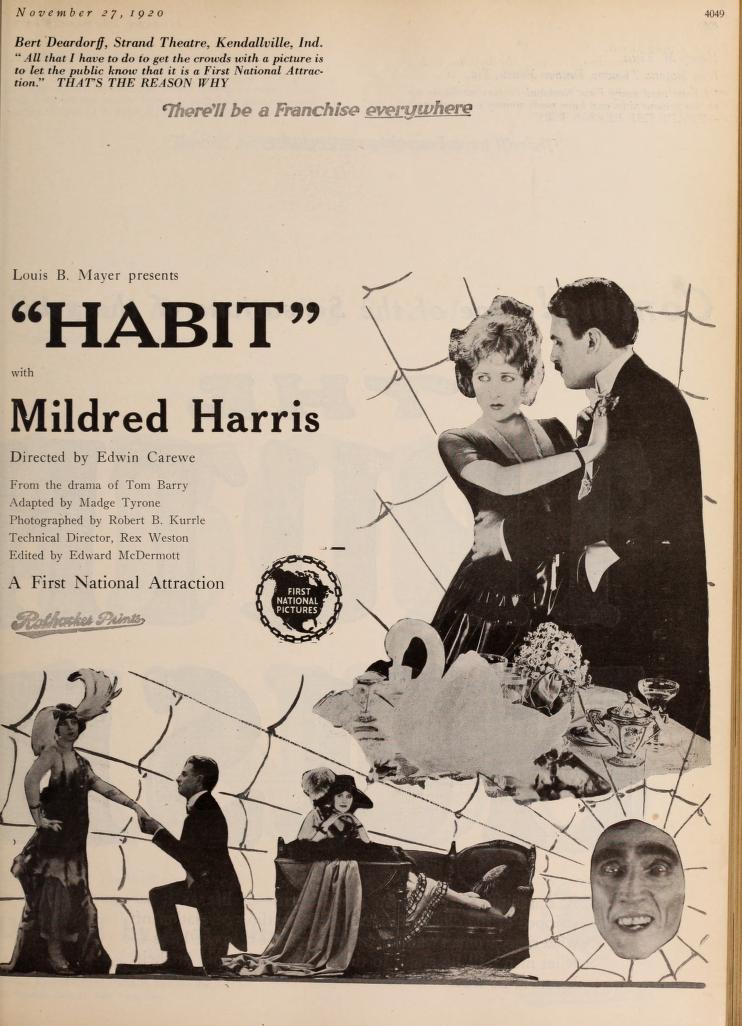
Madge Tyrone is credited with the adaptation of Habit (1920), which was directed by her friend Edwin Carewe. Motion Picture News, Nov. 27, 1920.
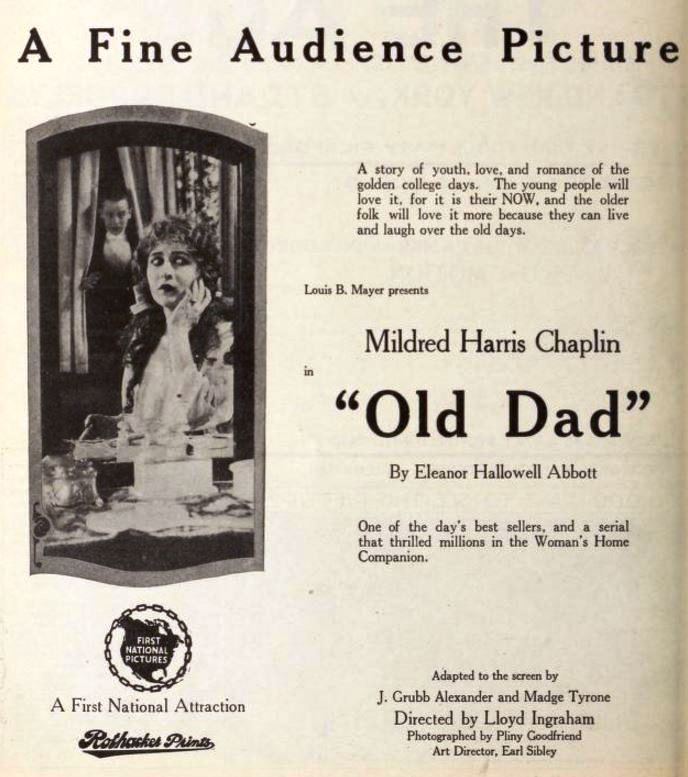
The adaptation of Eleanor Hallowell Abbott’s story was credited to J. Grubb Alexander and Madge Tyrone.
Around the time of her divorce, Tyrone returned to the motion picture industry. Her discoverable credits as a scenarist and title writer begin in 1920, when she started working with Louis B. Mayer, first in New York and then in Los Angeles. Mayer, who went on to found Metro-Goldwyn-Mayer (MGM) in 1924, had an up-and-coming studio in Los Angeles at 3800 Mission Road, where he produced features and short films, with business offices on West 48th Street in New York. A press announcement regarding her return to Hollywood referred to Tyrone as a “former newspaper woman and magazine writer,” suggesting that at some point she worked as a journalist as well (“Madge Tyrone Returning”). In 1920, Margaret Towle (as she recorded her name in the census) was living at 1854 N. Vermont Avenue, just a few blocks from Barnsdall Park, where Frank Lloyd Wright’s Hollyhock House was under construction. Towle, who identified herself in the Federal Census that year as a thirty-six-year-old “scenario writer,” lodged with three other single women in their thirties and forties, two divorcées who performed as vocalists and one widow with no listed occupation (“Margaret E. Towle”).
Tyrone wrote dialogue and narration that would appear on screen; she also adapted previously published stories and novels. She was soon being described in the press as “one of filmdom’s cleverest subtitlers” (“‘Old Dad’ at the Rex”). At a time when on-screen credits for writing and titling were spotty, it is notable that at least ten films can today be definitively credited to Madge Tyrone. Tyrone’s work, however, was interrupted by an automobile accident in January 1921, in which she sustained “a severe injury” when her “automobile skidded and turned turtle in an attempt to avoid collision with another car” (The Los Angeles Evening Express). Tyrone was “rapidly recovering” at the Clara Barton Hospital until, a month later, she went home to recuperate (“Stage and Screen”). In mid-March, she had recovered enough to return to work as a “member of the scenario staff” with Louis B. Mayer (“Scenarioist at Work”).
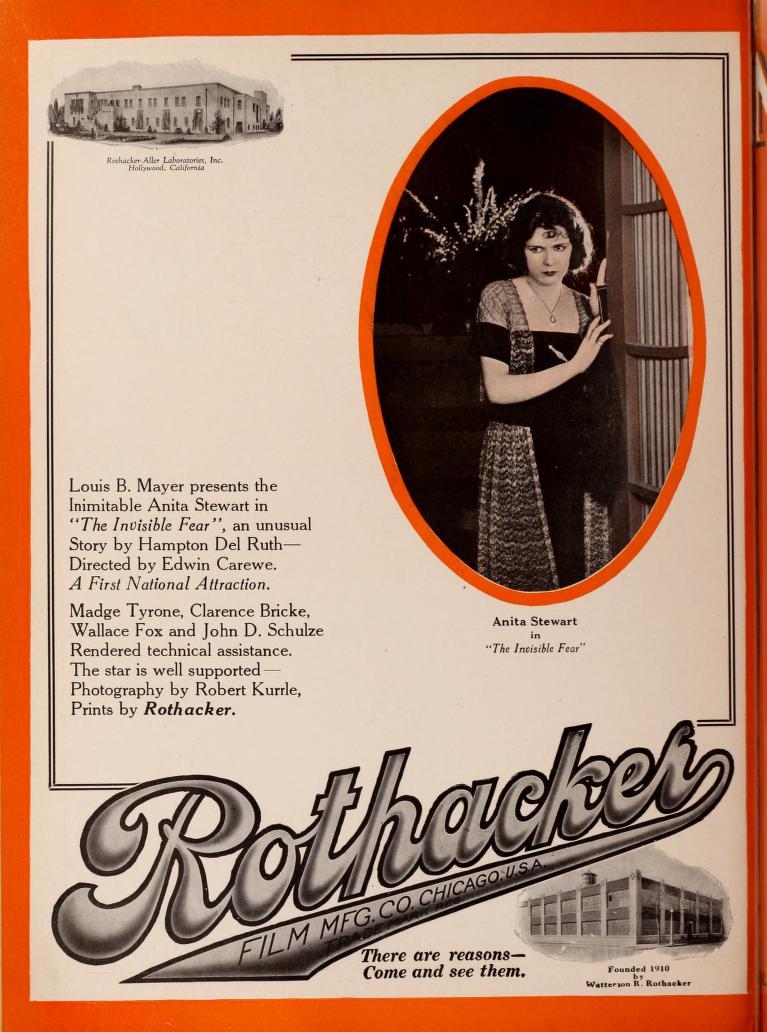
An ad mentioning Madge Tyrone’s “technical assistance” on The Invisible Fear (1921), Motion Picture News, Oct. 22, 1921.
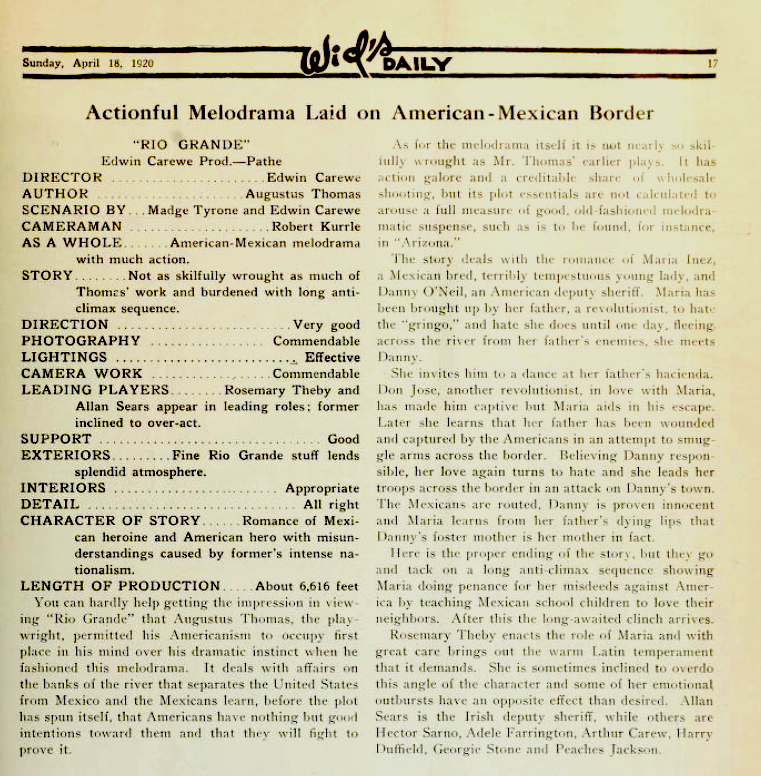
A review of Rio Grande (1920) crediting the scenario to Madge Tyrone and Edwin Carewe. The Film Daily, April 18, 1920.
Reviews for the pictures Tyrone worked on, such as The Invisible Fear (1921), fashioned her as a significant contributor. “In his treatment of Madge Tyrone’s scenario,” wrote one reviewer, “Director Edwin Carewe has succeeded in keeping up the suspense of the plot” (“The ‘Invisible Fear’”). Although Tyrone wrote the scenario for this film, advertisements for The Invisible Fear also touted her unspecified “technical assistance,” suggesting that she may have done additional work on the film’s production, perhaps in the editing room given her later work in this capacity.
In a 1922 article, Carewe praised Tyrone along with scenario writers June Mathis, Jeanie MacPherson, and Frances Marion for having “at their command that most important thing, visualization. The action moves through their minds in the form of pictures and from the action arises the fit title to each scene.” He described the photoplay script as “the blue print from which the builder works” and touted the importance of the “continuity writer” (“Writer Makes or Mars Pictures”). Carewe was not alone in his high estimation of Tyrone’s talents. Along with Anita Loos, Lucita Squier, and Dorothy Farnum, she was singled out as one of “the most important women playwrights” working with Louis B. Mayer (“Gossip Street” 34). This observer also perceived that the “long list of women who have contributed to the success of [the studio’s] photoplays reveals that there are hundreds of America women gaining fame as authors and scenarists.” In fact, one might say that women’s work in this area of the industry was in the process of being normalized.
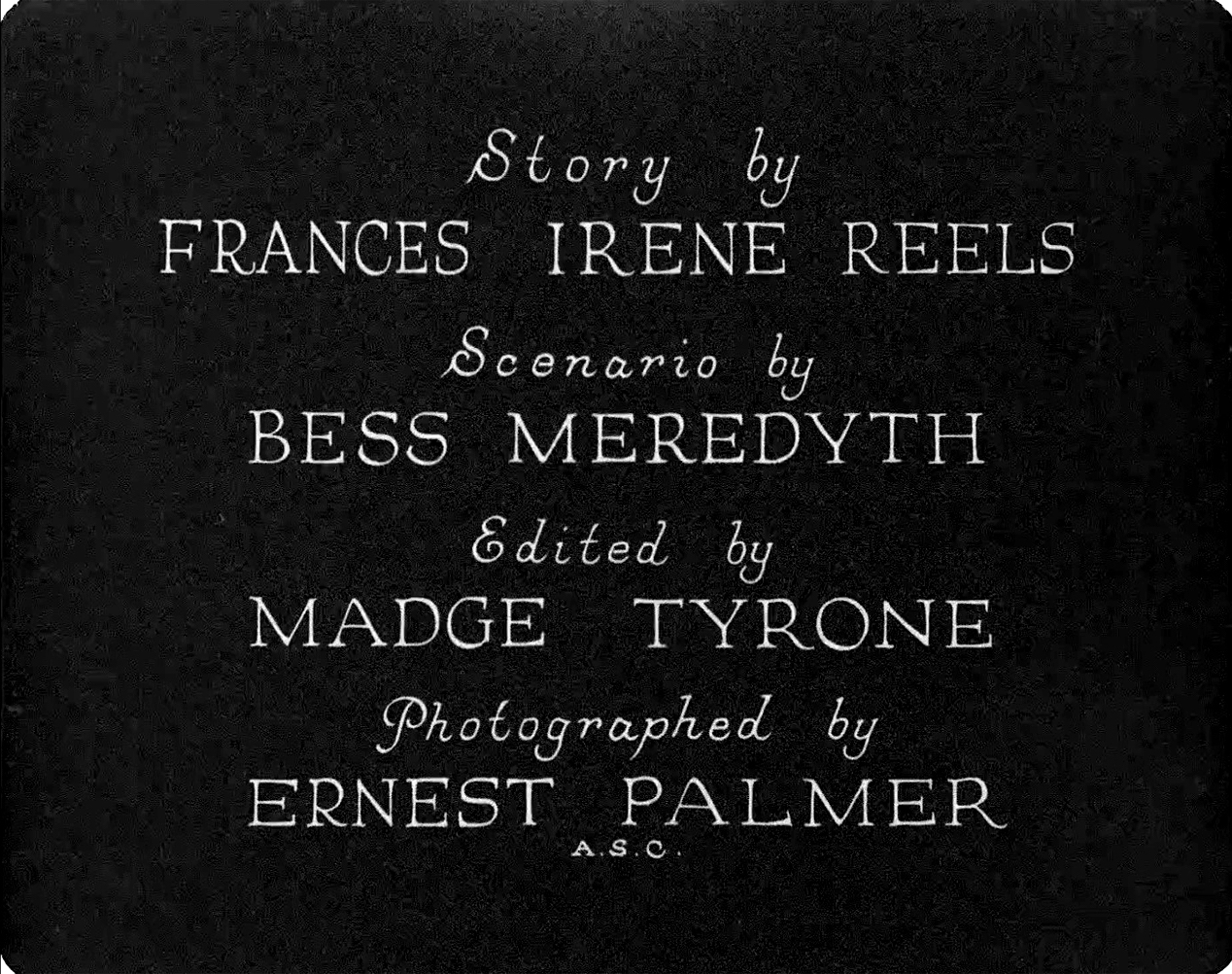
Screenshot of digitized credit sequence for The Song of Life (1922). Courtesy of the Library of Congress National Audio-Visual Conservation Center.
Tyrone also earned at least three screen credits for editing, on The Child Thou Gavest Me (1921), One Clear Call (1922), and The Song of Life (1922), all directed by John M. Stahl. From contemporary press mentions, we also know that she served as editor on Stahl’s presumed lost The Woman in His House (1920), for which she also wrote the scenario from a story by Frances Irene Reels (“Here and Expected”; “The Woman in His House”). It is unclear how she transitioned between writing and editing, or why. Was this was an exploration of a possible new line of work for a woman who had boundless curiosity and enjoyed learning new things? Was this work she only did for Stahl? Unfortunately, there is no extant documentation relating to her professional life or career decisions. At minimum, however, we know that she was good at the job: The Child Thou Gavest Me was a hit, inspiring H.B. Wright, manager of the Strand Theater in Seattle, Washington, to call it “the best picture I have played this season, both from a box-office angle and satisfied audiences” (“The Child Thou Gavest Me”).
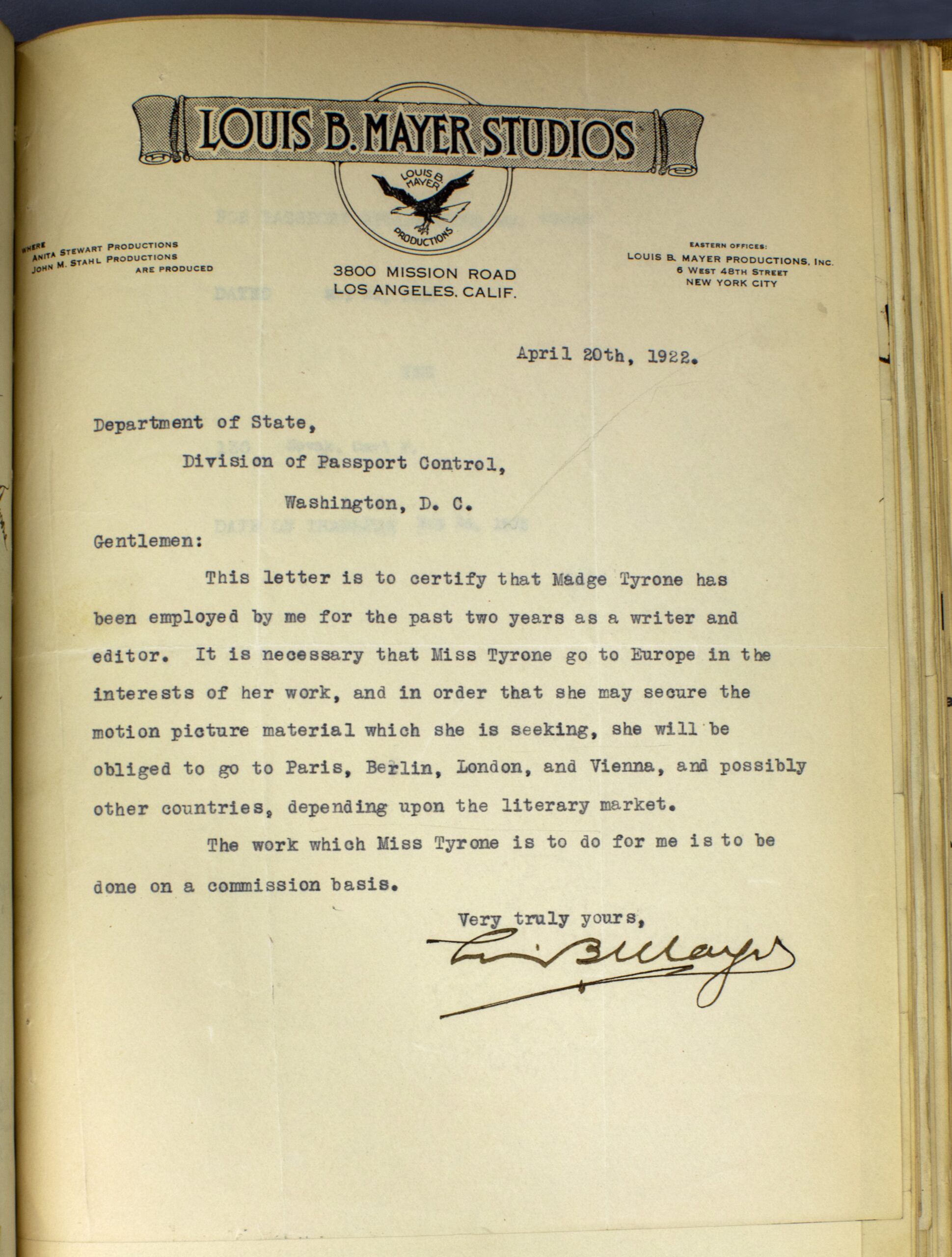
A Letter from Louis B. Mayer to the Department of State, April 20, 1922. Courtesy of the National Archives and Records Administration.
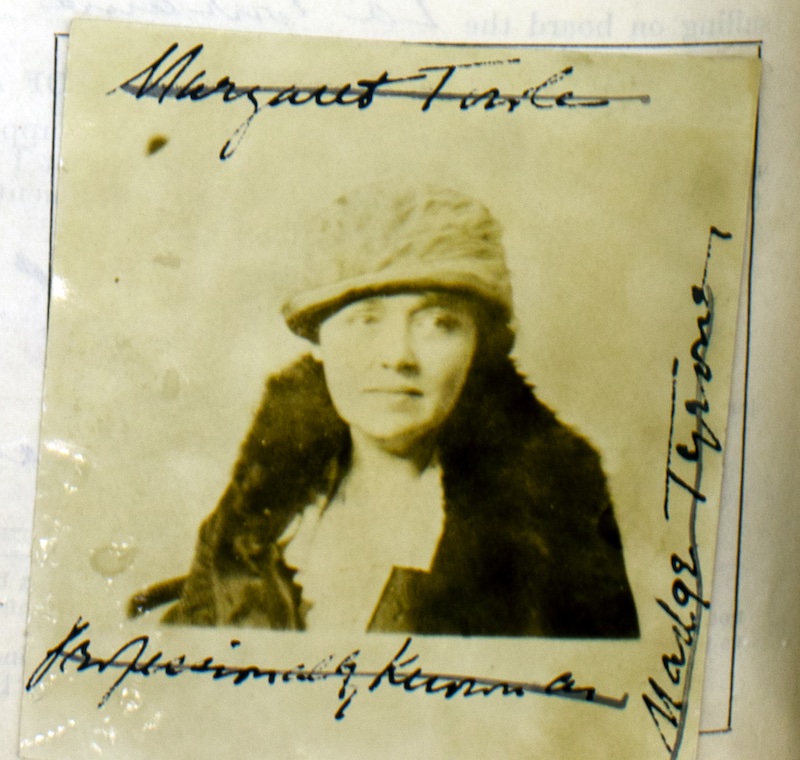
Madge Tyrone’s photograph submitted with her passport application, on which her birth name is scratched out. Courtesy of the National Archives and Records Administration.
In the early 1920s, Tyrone continued working steadily for Mayer, whose future studio, MGM, would produce her younger half-sister Ursula Parrott’s (née Katherine Towle) first novel-to-film adaptation, The Divorcee (1930), several years later. The Film Yearbook, 1922-1923 lists Tyrone as the Scenario Editor for Louis B. Mayer productions on West 48th Street in New York City, indicating that she had returned east. On April 29, 1922, Mayer wrote to the Department of State to support Tyrone’s passport application. (When she went abroad in 1913, there was no enforcement of travel documentation.) Mayer vouched that Tyrone had been working with him as a “writer and editor” for the past two years. “It is necessary that Miss Tyrone go to Europe in the interests of her work,” Mayer explained, “and in order that she may secure the motion picture material which she is seeking, she will be obliged to go to Paris, Berlin, London, and Vienna, and possibly other countries, depending on the literary market” (“Margaret Towle”). Abroad she went, returning to New York in February 1923 and then heading west again to Los Angeles, where she kept writing until she earned her final writing credit (with Lois Zellner) in 1925 for The Lady Who Lied, an adaptation of Robert Hitchens’ novel Snake-Bite (1919).
After abandoning her motion picture career for reasons unknown, Tyrone returned east to New York and Massachusetts. She took to the stage again, performing a singing role in March 1926 at the annual Irish night celebration of the St. Alphonsus Association of Roxbury, Massachusetts, in a vaudeville act that included Gaelic singers, step dancers, and a playlet called “The Irish Millionaire” (“St. Alphonsus Ass’n”). In May, she played the role of Ada May in “Easy Come, Easy Go,” a three-act farce at the Park Theater in Boston (“Mirthful Farce”). In April 1928, she appeared in “Marriage on Approval” in New York, which on Thursday afternoons admitted only women. This was not a play, but rather a grouping of speakers discussing the subject of marriage (“For Women Only”). If a transcript of this performance survived, we might know much more about the sole marriage and divorce of Margaret Towle.
When her father, Dr. Henry Towle, died in the fall of 1930, Margaret was at his bedside (“Death of Dr. Henry. C. Towle”). A decade later, in 1940, fifty-six-year-old Margaret Towle was living in Greenwich Village at 52 Barrow Street between Bedford and Bleecker. She identified herself in the Federal Census as single instead of divorced, and as a writer (of what, she did not indicate) with a modest income of $1,000 a year (“Margaret Towle”). When she died on April 13, 1955, her death notice in The New York Times used an aptly hybrid name, Madge Tyrone Towle, to announce her requiem mass and interment at the Catholic Gate of Heaven Cemetery in New York (“Deaths”).
It is certain that Tyrone wrote, and perhaps edited, much more than I could identify here. In this early 1920s period, her contributions were far from novel or unique; being a woman writer or editor was, for the most part, uncommented upon in the advertising campaigns for, or the press coverage of, the films she worked on. Instead, Tyrone was part of a valued, well-known, and sizable female cohort of industry workers, respected by their colleagues and bosses for the quality work they produced. That Tyrone transitioned between acting, writing, and editing indicates a kind of fluidity in the industry that would disappear over the course of the 1920s, especially for women whose options behind the camera were in the process of greatly diminishing.
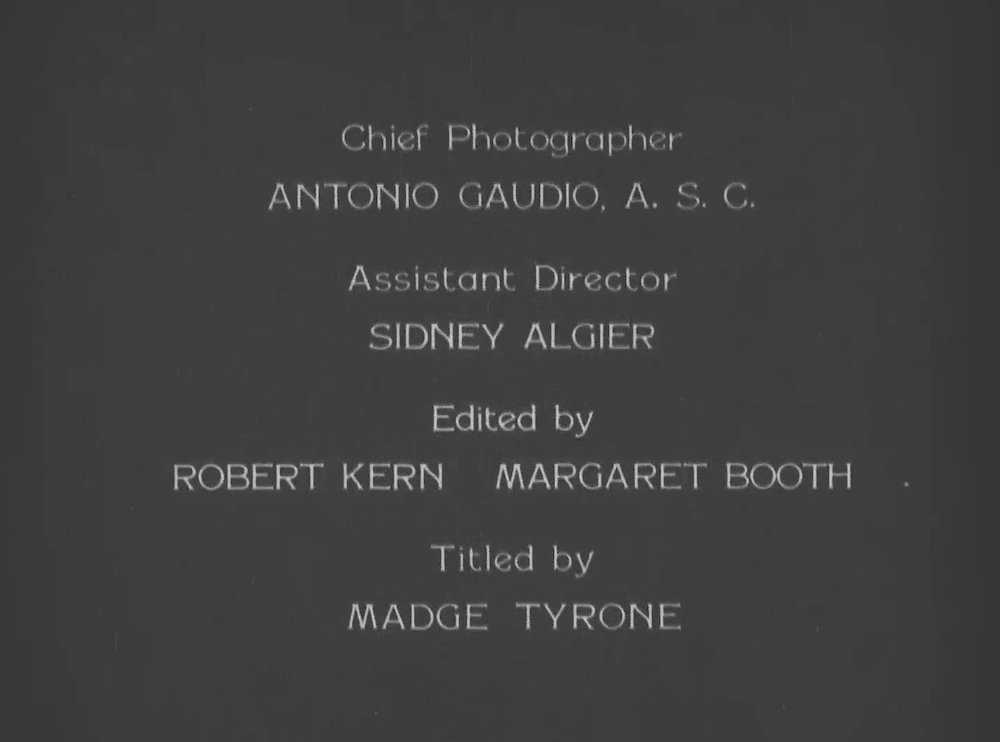
Screenshot of digitized credit sequence for Husbands and Lovers (1924). Courtesy of the Library of Congress National Audio-Visual Conservation Center.
